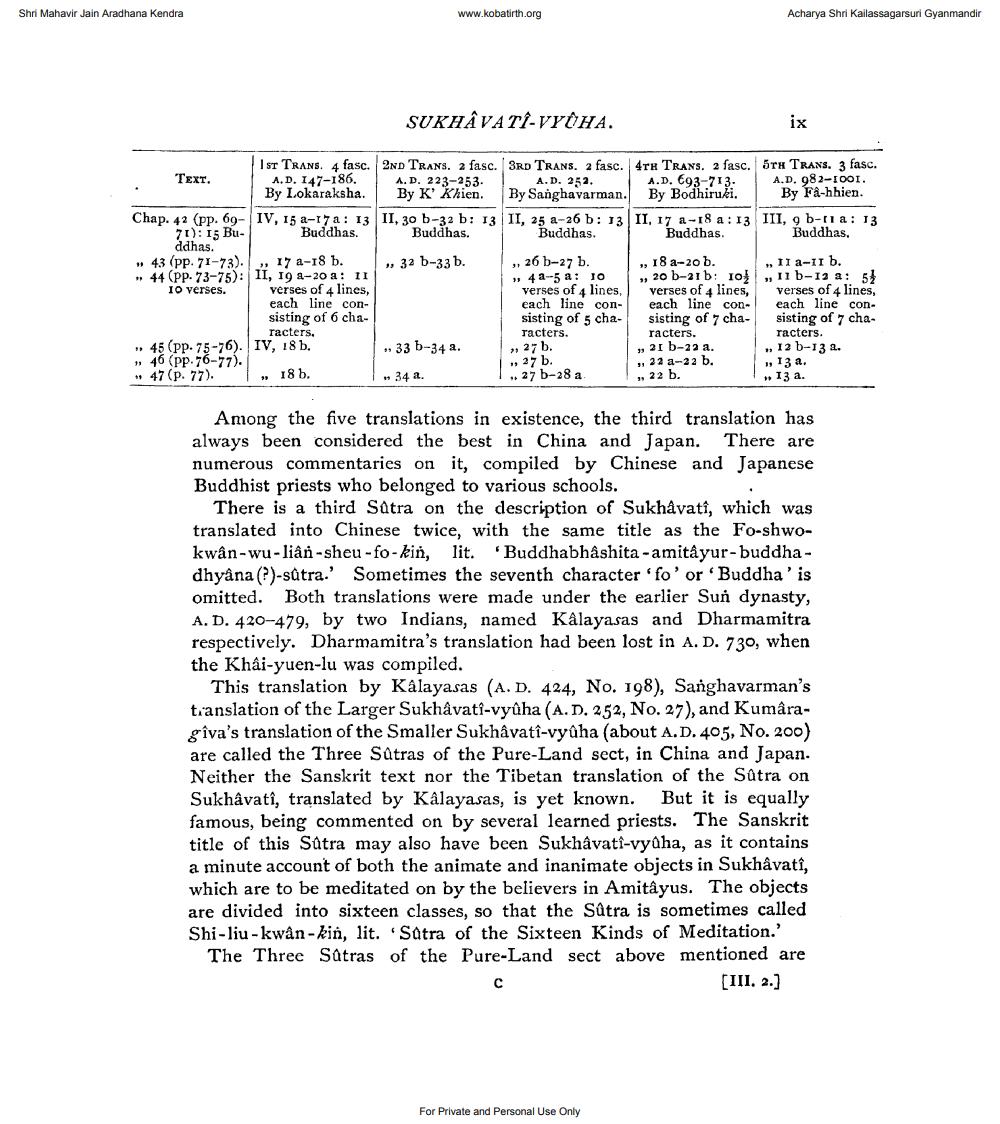________________
Shri Mahavir Jain Aradhana Kendra
www.kobatirth.org
Acharya Shri Kailassagarsuri Gyanmandir
SUKHÂVATI-VYUHA.
ix
TEXT.
Is Trans. 4 fasc. 2ND TRANS. 2 fasc. 3RD TRANS. 2 fasc. 4TH Trans. 2 fasc. 5TH TRANS. 3 fasc. A.D. 147-186. A. D. 223-253
A.D. 252.
A.D. 693-713. A.D. 982-TOOI. By Lokaraksha. By K' Khien. By Sanghavarman. By Bodhiruki. By Fa-hhien. Chap. 42 (pp. 69-IV, 15 -17a: 13 II, 30 6-32 b: 13 II, 25 a-26 b: 13 II, 17 a -18 a:13 III, 9 b-11 a: 13 70):15 BuBuddhas. Buddhas.
Buddhas. Buddhas.
Buddhas, ddhas. 43 (pp. 71-73). , 17 a-18 b. , 32 b-33 b. ,, 26 b-27 b. , 18 a-20 b.
1. II a-II b. 44 (PP. 73-75): II, 194-20 a: 11
42-5 a: 10 ,, 20 b-21b: 101,11b-13 a: 51 10 verses. verses of 4 lines,
verses of 4 lines, verses of 4 lines, verses of 4 lines, each line con
each line con- each line con- each line consisting of 6 cha
sisting of 5 cha- sisting of 7 cha- sisting of 7 characters.
Tacters. racters.
racters. 45 (pp. 75-76). IV, 18 b.
, 33 b-34 a. ► 27 b. 321 b-22 a.
- 12 -13 2. → 46 (PP. 76-77).
,, 27 b. ,, 22 a-22 b.
13 a. + 47 (p. 77). 1 , 18 b.
.. 34 a. .. 27 b-28 a
13 a.
22 b.
Among the five translations in existence, the third translation has always been considered the best in China and Japan. There are numerous commentaries on it, compiled by Chinese and Japanese Buddhist priests who belonged to various schools.
There is a third Sutra on the description of Sukhavati, which was translated into Chinese twice, with the same title as the Fo-shwokwân-wu-liân-sheu - fo-kin, lit. "Buddhabhashita-amitảyur-buddhadhyana -sútra.' Sometimes the seventh character 'fo' or Buddha'is omitted. Both translations were made under the earlier Sun dynasty, A. D. 420-479, by two Indians, named Kalayasas and Dharmamitra respectively. Dharmamitra's translation had been lost in A. D. 730, when the Khâi-yuen-lu was compiled.
This translation by Kalayasas (A. D. 424, No. 198), Sanghavarman's translation of the Larger Sukhâvatî-vyûha (A.D. 252, No. 27), and Kumâragiva's translation of the Smaller Sukhâvatî-vyûha (about A.D. 405, No. 200) are called the Three Satras of the Pure-Land sect, in China and Japan. Neither the Sanskrit text nor the Tibetan translation of the Satra on Sukhâvatî, translated by Kalayasas, is yet known. But it is equally famous, being commented on by several learned priests. The Sanskrit title of this Satra may also have been Sukhâvati-vydha, as it contains a minute account of both the animate and inanimate objects in Sukhåvati, which are to be meditated on by the believers in Amitâyus. The objects are divided into sixteen classes, so that the Sutra is sometimes called Shi- liu-kwân-kin, lit. Satra of the Sixteen Kinds of Meditation.' The Three Satras of the Pure-Land sect above mentioned are
[III. 2.)
For Private and Personal Use Only




